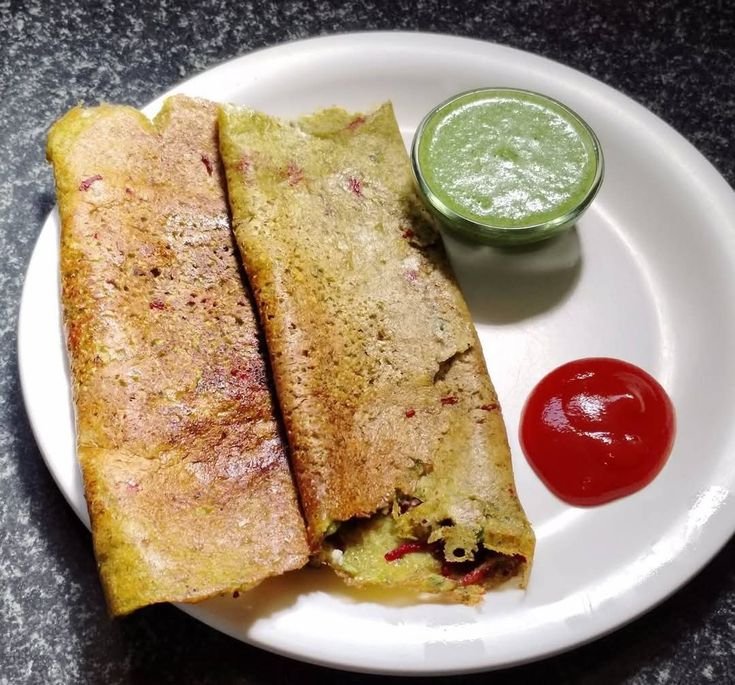
There is something wonderfully comforting in a steaming, aromatic plate of paneer tikka, perhaps most especially when it is prepared satvik style — no onion, no garlic, no sly devices, just good ingredients, clean prana, and mucho amor. If you’ve ever sat on a temple courtyard after bhajan-kirtan and been served prasad that made you close your eyes and smile, you know exactly what I’m talking about. Satvik food has this soft, nourishing energy that not only fills your belly but also feeds your soul.
This paneer tikka is not about overpowering masalas or smoky grills. It’s all about balance — the fresh, creamy paneer, the soothing warmth of spices like cumin and turmeric, the gentle tang of curd, and the earthiness of roasted vegetables. It’s food that tastes like a warm hug from inside out. And the best part? It’s ridiculously simple to prepare at home, even without a tandoor or special equipment.
So I’ll take you through the way I do it in my kitchen at home — not the way it’s done in the book, but the way we do it when cooking with bhav and in simplicity.
What Makes This Recipe Satvik?
Let’s get that cleared first.
In a satvik diet, we also shun tamasic and rajasic foods — no garlic, no onions, no mushrooms, no fermented foods, and we make spices mild, not hot. The idea is to keep the mind clear and the body light.
Instead of looming garam masalas, we employ like jeera (cumin), dhania (coriander), haldi (turmeric), and occasionally hing (asafoetida) for depth. Rather than yogurt resting in the fridge for the past week, we employ fresh curd. Everything is served with a calm mind, usually chanted over or made in silence.
That’s the sort of paneer tikka we’re preparing today.
Ingredients (Feeds 2-3 People Generously):-
For the Marinade:
250g fresh paneer (homemade or bought, firm and cubed)
1/2 cup thick curd (homemade, lightly hung till thick)
1/2 tsp turmeric powder
1/2 tsp cumin powder (jeera)
1 tsp coriander powder (dhania)
1/2 tsp black pepper powder
1/2 tsp rock salt (sendha namak) or regular salt
1 tsp lemon juice or juice of half a lemon
1/2 tsp grated fresh ginger (optional, for added depth)
1/4 tsp hing (asafoetida)
A dash of sugar (to counteract the tartness of curd)
1 tbsp mustard oil or cold-pressed sesame oil
Vegetables (Optional but Recommended):
1 small capsicum (red, yellow, or green), cut into 1-inch pieces
1 small tomato, deseeded and chopped into chunks
1 small cucumber or zucchini (for that cooling sensation), sliced thick
Few cubes of boiled potato or sweet potato (optional, but yummy)
Preparation – Slow and Mindful:-
Step 1: Hung Curd is Key
If your curd is too watery, your marinade will be dripping. Take a muslin cloth or clean kitchen towel, place the curd in it, and suspend it for 30–45 minutes. Even 20 minutes will do if you are short of time. What we are looking for is thick, creamy curd that sticks to the paneer and vegetables.
( Chant Hare Krishna Mahamantra for more tasteful flavour )
Step 2: Prepare the Marinade
Add the hung curd in a large mixing bowl. On top of it, add the turmeric, cumin powder, coriander powder, pepper, salt, hing, lemon juice, ginger, sugar, and oil. Mix everything well, not too vigorously, using a wooden spoon or your own hands — it’s always nicer when you mix with your hands, especially when you’re cooking with love.
The marinade must smell nice, a little tangy, and smooth on your fingers.
Step 3: Add Paneer and Veggies
Add your paneer cubes and veggies to the marinade. Coat everything with your hands thoroughly but gently — imagine massaging love into the ingredients. After coating, set them aside. If you can, keep it covered in the refrigerator for 30 minutes to 2 hours. In case you don’t have time, even 15–20 minutes is fine.
Occasionally, I mutter a little prayer or listen to gentle bhajans while doing this. It’s all about the energy you are transferring into the food.
Cooking Options (No Tandoor, No Issue):-
Option 1: Tava or Grill Pan (My Favorite)
Heat a flat non-stick or cast-iron pan. Add oil drops, and gently put the marinated paneer and veggies into it. Maintain the flame at medium.
Leave one side to cook until there are golden spots. Flip softly. Don’t overcrowd the pan — give them space.
The marinade may stick a bit, but that’s fine. Scrape it off and let it crisp up slightly — those pieces are packed with flavor.
Option 2: Oven or OTG:-
Preheat your oven to 200°C (approximately 390°F). Grease a baking tray with parchment or foil, oil lightly. Place your marinated paneer and vegetables, and bake for 15–20 minutes. Flip once halfway.
If you desire the charred appearance, place the broil option for the final 2 minutes.
Option 3: Air Fryer:-
Yes, works perfectly. Heat the air fryer to 180°C. Place the pieces in one layer and fry for 10–12 minutes, turning once halfway through.
Serving: More Than Just Presentation:-
Satvik food must be served freshly cooked and hot, on a clean thali or banana leaf if you possess one. No plastic, no microwave warming. Only plain, genuine presentation.
I prefer to serve the paneer tikkas on a steel plate, drizzle a small amount of lemon juice, and garnish with a few finely chopped coriander leaves. A pinch of roasted jeera powder may also be added at the top.
Serve with:
A fresh coconut-corainder chutney (garlic-free)
A couple of slices of cucumber and tomato
A small ramekin of homemade curd or mint buttermilk
A Few Gentle Notes:-
1. Avoid Over-Spicing
Resist the urge to add red chili powder or garam masala. It alters the prana of the dish. If you must have a kick, add a pinch of fresh black pepper.
2. Freshness is Key
Attempt to use fresh paneer, fresh curd, and freshly ground spices if at all possible. In satvik cuisine, the prana (life energy) of food is greater than shelf life.
3. Intention is All
I know it sounds corny, but how you cook is important. Even a humble paneer tikka turns to prasadam if you cook it with bhakti — devotion, love, simplicity. If you chant mantras while cooking or just have clean, peaceful thoughts, that too contributes to the final food.
Why I Love Making This Dish Often
This paneer tikka has turned into a kind of home weekend ritual. I forego the onion-garlic on Saturdays or ekadashi days and make this instead. Occasionally as a night snack, occasionally as a part of a larger thali. It’s light but not hungry-making. It satiates guests but is uncomplicated enough for daily consumption. And the best part — it feels good in the body.
Even my father, a staunch “masaledaar” foodie himself, now likes this version. He feels it doesn’t make him “heavy” after, and I concur. It feels satisfying without that after-meal grogginess.
Last Thoughts:- From My Kitchen to Yours
Satvik paneer tikka is not merely a recipe — it is a humble celebration. Of simplicity. Of sustenance. Of pleasure in cooking. Of sharing food that tastes right, not merely good.
In this whirlwind world, where everything revolves around “what’s trending” or “what’s next,” recipes like these force us to slow down. To bond. To cook with two hands and heart.
So when you’re in the mood for something delectable, try this satvik style paneer tikka. Let the serenity of its ingredients and the warmth of your own hands transform it into something beyond just a meal.
And when you do make it, serve it hot, perhaps share it with another, perhaps recite a soft mantra before you take your first bite. Food is transformed into magic this way.
Hare krishna🙏



